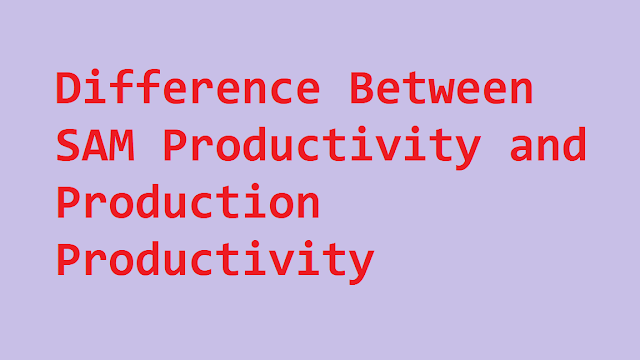What is the difference between SAM Productivity and Production Productivity? Asked by an OCS reader.
SAM productivity and production productivity both are new terminologies. Though this is the first time I come across these productivity terms, I can relate and explain how these productivity can be calculated.
Let me first define these two terms and then I will compare.
SAM productivity
SAM productivity can be defined as total SAM produced by per operator per shift. SAM productivity is measuring the manufacturing productivity of a production line or a factory in terms of standard time produced per operator.For an example, let's say in a line 40 operators make 400 shirts in a day (8 hours shift time) and SAM of that shirt is 25 minutes. SAM productivity will be (25*400)/40 minutes= 250 minutes per operator per shift
Production productivity
Production productivity is similar to the labor productivity and machine productivity. In these cases, productivity is presented in production quantity.
Labor productivity: Number of garments produced per labor per shift.
Consider the above example, in a production line 40 operators and 5 helpers made 400 garments in a 8 hours shift. Total labor count is 40+5 = 45. Labor productivity of that line will be (400/ (40+5)) = 8.89 pieces per labor per shift.
Machine productivity: Number of garment produced by machine per shift.
Machine productivity: Number of garment produced by machine per shift.
Let's say, in a line 40 machine is used to make 400 garments in a 8 hours shift. Machine productivity of that line will be (400/ 40) = 10 pieces per labor per shift.
Difference between SAM productivity and Production Productivity.
Here I have listed few points to compare these two productivity terms.
#1. SAM productivity is presented in standard minutes produced irrespective of product SAM. On the other hand the production productivity is presented as number of garment produced.
#2. Through SAM productivity you can easily compare performance of two lines or two factories, irrespective of the apparel product types, style.
When you use production productivity (labor productivity / machine productivity), comparison of two line's performance can be done when they make same style and same product. If two lines make two different products having different SAM, performance can not be compared with produced qty.
#3. You can measure production productivity of a factory or a line without having product SAM. But to measure SAM productivity you need to know product SAM.
Garment factories those don't have IE and don't estimate the standard minutes (SAM) for their styles, can not calculate SAM productivity. But they can easily calculate production productivity.
Read the difference between labor productivity and efficiency
Do you use these measures in your garment factory? Have you seen people using these two types of productivity?
Read the difference between labor productivity and efficiency
Do you use these measures in your garment factory? Have you seen people using these two types of productivity?
I would be great learning if you can share your understanding on the SAM productivity and Production productivity.

